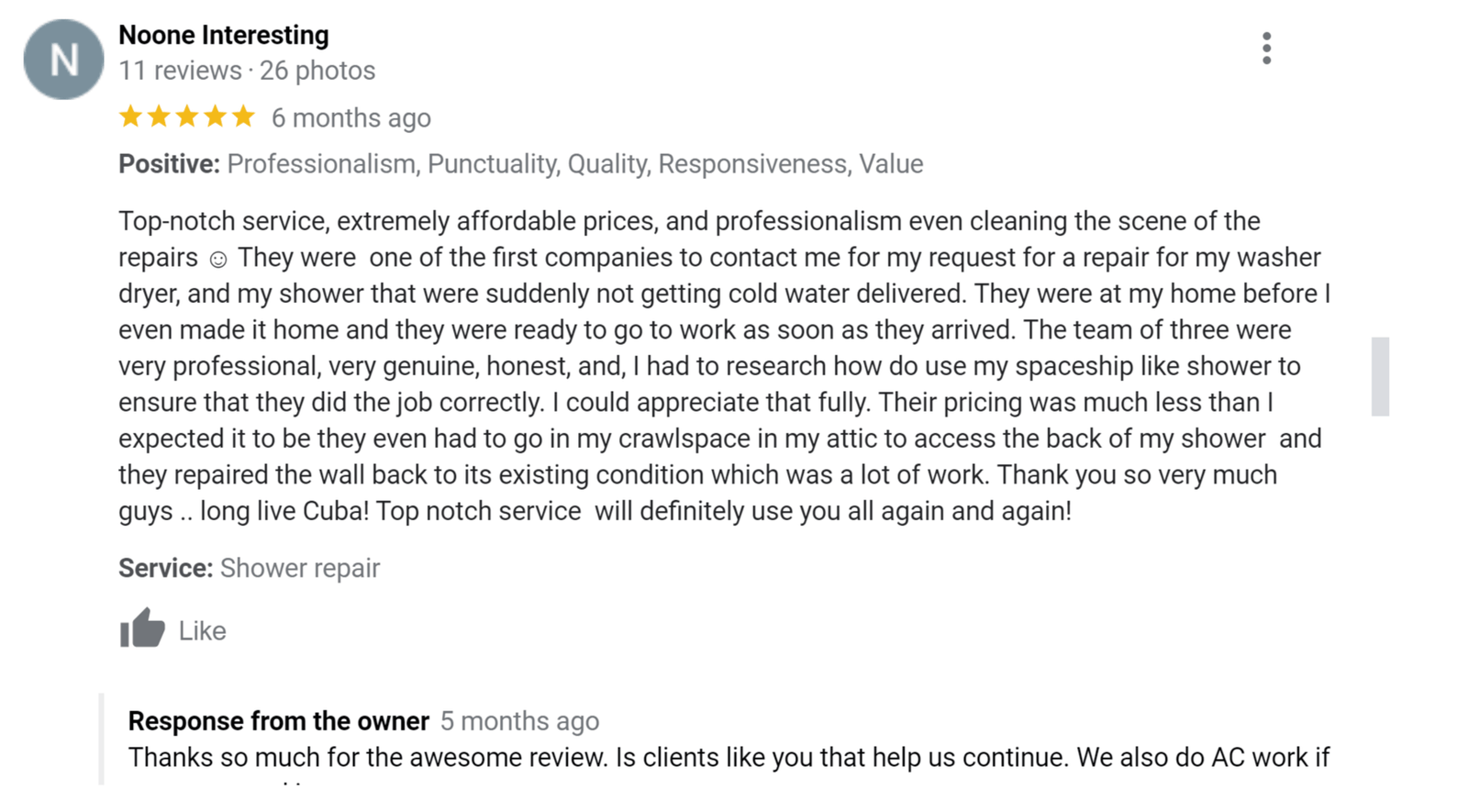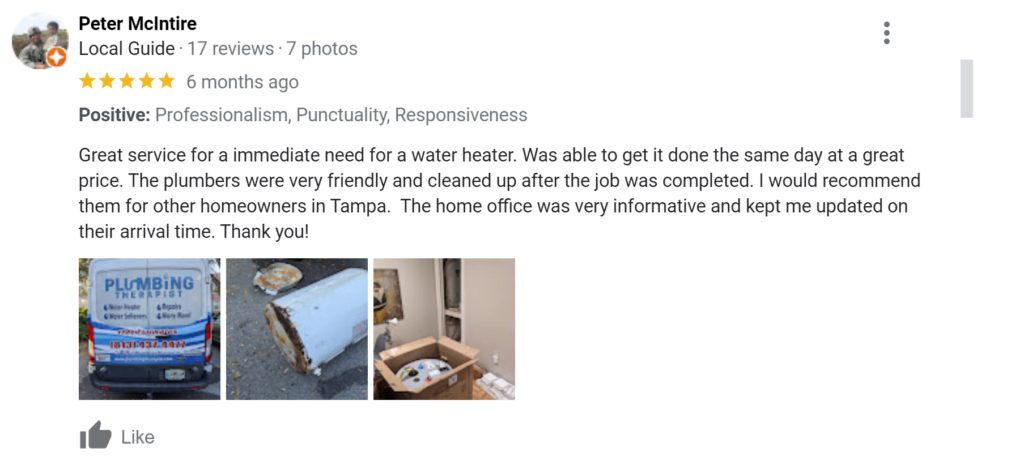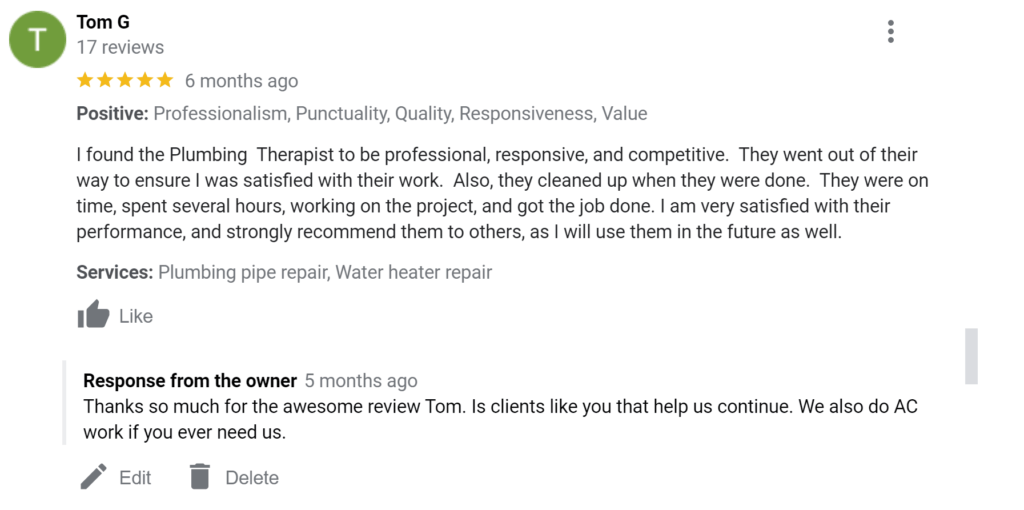Reverse Osmosis Installation
At Plumbing Therapist, Reverse Osmosis Installation is the key to pure, great-tasting water. We remove contaminants, ensuring you enjoy the best hydration.
Do You Need Our Help ?
Feel free to contact us now
$99 Water Heater Flush + Free Plumbing System Inspection
Reverse Osmosis Installation in Tampa Bay
Purify Your Tap Water with Plumbing Therapist's RO Installation in Hillsborough County, Pinellas County, and Pasco County
Reverse Osmosis (RO) is a state-of-the-art water purification process. It utilizes a semipermeable membrane to remove impurities, contaminants, and even microscopic particles from your tap water. This results in water that is exceptionally clean, clear, and free from harmful substances.
Why Should You Get an RO System?
Pristine Water Quality: Enjoy water that tastes and smells better, with no chlorine or unpleasant odors.
Health Benefits: Reduce your exposure to contaminants and pollutants, promoting better health for you and your family.
Convenience: Ditch the hassle and cost of buying bottled water, as you’ll have pure water at your fingertips.
Environmentally Friendly: Embrace an eco-friendly solution by reducing plastic waste and conserving water.
Why Choose Plumbing Therapist for Reverse Osmosis Installation?
Local Expertise: We’re your trusted Tampa neighbors, with in-depth knowledge of the local water quality challenges and solutions.
Top-Notch Service: Our team consists of highly skilled technicians who specialize in RO installation, ensuring a seamless process from start to finish.
Custom Solutions: We tailor our RO systems to your specific needs, considering factors like water quality and your household’s water usage.
Quality Assurance: Plumbing Therapist only uses top-quality RO systems and components, guaranteeing long-lasting performance.
Exceptional Customer Care: We prioritize your satisfaction, providing ongoing support and maintenance to keep your RO system in perfect condition.
When it comes to Reverse Osmosis Installation in Tampa, Plumbing Therapist is the perfect choice. We’re dedicated to delivering clean, healthy, and great-tasting water to your home. Contact us today to experience the difference RO can make in your life. Your water, our expertise, a perfect match!

Why partner with Plumbing Therapist?
Quality, Affordability, and Expertise.

No Hidden or Unexpected Charges

Free Estimates & Online Booking Available

Professionally Trained Technicians

Honesty is Guaranteed

Quick Communication & Service Within 24 Hours

400+ 5 Star Reviews

What are the benefits of a Reverse Osmosis installation?
A Reverse Osmosis (RO) installation by Plumbing Therapist in Tampa, Florida, brings a multitude of benefits to your home and your family’s well-being:
Exceptional Water Purity: Plumbing Therapist’s RO systems guarantee water that’s free from contaminants, delivering a noticeable improvement in taste and odor.
Healthier Living: With RO, you reduce your exposure to potentially harmful substances, ensuring your family’s health and safety.
Cost-Efficiency: By eliminating the need for bottled water, our RO installation saves you money in the long run, all while reducing plastic waste.
Eco-Friendly Choice: Plumbing Therapist is committed to sustainability. Our RO systems contribute to a greener environment by minimizing plastic waste.
Convenience: Say goodbye to the inconvenience of heavy water jugs. Plumbing Therapist’s RO systems provide a continuous supply of clean, pure water directly from your tap.
Appliance Protection: RO water is gentler on your appliances, extending their lifespan by preventing mineral buildup.
Crystal-Clear Ice: Enjoy visually appealing, clear ice cubes in your beverages, enhancing the overall experience.
Better Cooking and Food Quality: Your culinary creations and beverages taste better with RO water, elevating your cooking and dining experiences.
Plumbing Therapist in Tampa, Florida, is your trusted partner for RO installation. We offer custom solutions that match your specific needs, ensuring your family enjoys the finest water quality available. Make the smart choice for your home and health with Plumbing Therapist’s Reverse Osmosis installation.
If you would like more information, feel free to give them a call at (813)-437-4477 or you can book online and get their latest discount!
Customer Testimonials: Real Experiences with Plumbing Therapist
We proudly share the experiences and stories of our valued clients. Their feedback provides a glimpse into the quality of service and commitment to excellence we uphold at Plumbing Therapist. You'll read firsthand how our plumbing solutions have improved comfort and efficiency in homes across Tampa Bay. These testimonials illustrate our dedication to customer satisfaction and the difference our expert services can make.




Your questions answered
Common Reverse Osmosis Questions:
What is reverse osmosis?
Reverse Osmosis (RO) is a water purification process that removes impurities and contaminants from water, making it exceptionally clean and pure. It works by using a semipermeable membrane to separate water molecules from dissolved minerals, chemicals, and other particles.
Here’s how reverse osmosis works:
Filtration: Water is first passed through a pre-filter to remove larger particles like sediment and debris.
Pressurization: The filtered water is then pressurized and forced through a semipermeable membrane. This membrane has tiny pores that allow water molecules to pass through while blocking larger molecules, contaminants, and impurities.
Collection: The purified water that passes through the membrane is collected and stored for use.
Concentration of Waste: The rejected impurities, including minerals and contaminants, are diverted away from the purified water and flushed down the drain, leaving you with clean, purified water.
Reverse osmosis is highly effective at removing a wide range of impurities, including:
- Heavy metals like lead and arsenic
- Dissolved salts and minerals
- Chemicals and pollutants
- Bacteria and viruses
- Chlorine and other unpleasant odors and tastes
The result is water that is significantly cleaner, clearer, and safer to drink and use for various household purposes. Reverse osmosis is a popular choice for improving water quality in homes, businesses, and industrial settings. It provides a reliable and efficient method for obtaining pure and healthy drinking water.
How much does it cost to install reverse osmosis?
The cost of installing a Reverse Osmosis (RO) system can vary depending on several factors, including the specific system you choose and the complexity of the installation. At Plumbing Therapist in Tampa, Florida, we offer competitive pricing and tailored solutions to meet your needs. On average, the cost for a basic RO system installation typically ranges from $300 to $600.
However, it’s essential to note that certain factors can impact the final cost:
Type of RO System: Different RO systems come with varying features and filtration capacities. More advanced systems may cost more but offer additional benefits.
Water Quality: If your water has significant contaminants or requires special treatment, it may necessitate additional pre-filtration or customization, affecting the cost.
Installation Complexity: The complexity of the installation, such as the distance between the RO system and the water source, can influence the cost.
Additional Features: Some homeowners opt for additional features like a dedicated faucet or water storage tank, which can add to the overall cost.
Maintenance Packages: Consider any maintenance packages offered by Plumbing Therapist to keep your RO system running smoothly. These may have associated costs but are essential for long-term performance.
For an accurate estimate tailored to your specific requirements, we recommend reaching out to Plumbing Therapist for a consultation. Our experienced technicians will assess your needs, recommend the right RO system for you, and provide a detailed cost estimate. We’re committed to delivering cost-effective and high-quality RO installation services to our Tampa, Florida, customers.
What are the pros and cons of reverse osmosis?
Reverse Osmosis (RO) is an effective water purification method, but like any system, it comes with its own set of pros and cons. Here’s a breakdown:
Pros:
Exceptional Water Purity: RO systems remove up to 99% of impurities, providing you with some of the cleanest water possible.
Improved Taste and Odor: Say goodbye to unpleasant tastes and odors in your water, such as chlorine or sulfur.
Health Benefits: RO systems effectively remove contaminants, making your water safer to drink and cook with, reducing health risks.
Environmental Impact: By reducing the need for bottled water, RO systems contribute to a decrease in plastic waste and are more environmentally friendly.
Cost Savings: Over time, RO systems can save you money compared to buying bottled water, as well as prolong the life of appliances by preventing mineral buildup.
Customization: RO systems can be tailored to address specific water quality concerns, such as hardness or the presence of specific contaminants.
Cons:
Wastewater: RO systems produce a certain amount of wastewater for every gallon of purified water, which can be seen as inefficient in terms of water usage.
Initial Cost: The upfront cost of purchasing and installing an RO system can be relatively high, depending on the system’s complexity and features.
Maintenance: RO systems require periodic maintenance, including filter changes, membrane cleaning, and sanitization, which can add to the overall cost.
Reduced Mineral Content: While RO removes contaminants, it can also strip essential minerals from the water. Some people prefer the taste of water with minerals.
Slower Flow Rate: RO systems typically have a slower flow rate than regular taps, so it may take a bit longer to fill containers or glasses.
Limited Contaminant Removal: While highly effective, RO systems may not remove some specific contaminants, such as certain volatile organic compounds (VOCs) or certain gases.
In summary, reverse osmosis offers outstanding water purification benefits, including improved taste, health advantages, and environmental benefits. However, it also has some drawbacks, such as wastewater production and initial costs. The decision to install an RO system should be based on your specific water quality concerns and needs.
Do I Need a Whole House Reverse Osmosis System?
Whether you need a whole house reverse osmosis (RO) system depends on your specific water quality concerns and requirements. Whole house RO systems are designed to treat all the water entering your home, providing purified water for every faucet and appliance. Here are some factors to consider when deciding if a whole house RO system is necessary:
Reasons to Consider a Whole House RO System:
Severe Water Quality Issues: If your water source has extremely high levels of contaminants, including salts, minerals, or harmful substances, a whole house RO system can provide comprehensive treatment for all water used in your home.
Health Concerns: If your primary concern is the health and safety of your family, and you want all water, including bathing and laundry water, to be of the highest quality, a whole house RO system can offer peace of mind.
Comprehensive Contaminant Removal: Whole house RO systems are effective at removing a wide range of contaminants, including heavy metals, chemicals, and dissolved minerals, providing you with exceptionally pure water for all purposes.
Consistency: With a whole house RO system, you have consistent water quality throughout your home, eliminating the need for additional point-of-use filters or treatment.
Considerations Against a Whole House RO System:
Cost: Whole house RO systems can be expensive to purchase, install, and maintain. You should weigh the cost against the specific benefits you seek.
Wastewater Generation: RO systems produce wastewater during the purification process. A whole house system will generate more wastewater compared to a point-of-use system.
Complexity: Installation and maintenance of whole house RO systems are more complex and may require professional assistance.
Water Pressure: RO systems can reduce water pressure, which may not be ideal for certain appliances or fixtures.
Ultimately, the decision to install a whole house RO system should be based on your water quality concerns, budget, and preferences. If you have serious water quality issues and want purified water for all uses, a whole house RO system can provide comprehensive treatment. However, if your primary concern is drinking water, a point-of-use RO system may be a more cost-effective solution. Consult with a water treatment professional to assess your specific needs and determine the best option for your home.
How Does Reverse Osmosis Work?
Reverse Osmosis (RO) is a water purification process that relies on a semipermeable membrane to remove impurities and contaminants from water. Here’s how it works:
Filtration: The process begins with the intake of untreated water, which contains various dissolved and suspended substances.
Pre-Filtration: Before entering the RO membrane, the water often passes through a pre-filter or sediment filter. This filter removes larger particles, such as sediment, sand, and debris, to prevent damage to the delicate RO membrane.
Pressurization: The water is then pressurized using a pump. The increased pressure is essential for forcing the water through the RO membrane.
Reverse Osmosis Membrane: The heart of the RO system is the semipermeable membrane. It contains tiny pores, so small that only water molecules can pass through, while larger molecules and contaminants are blocked. The pressure applied forces the water through these microscopic pores.
Separation of Clean Water and Concentrated Wastewater: As the pressurized water passes through the RO membrane, it separates into two streams:
- Clean Water: Purified water with most of the impurities removed passes through the membrane and is collected for use.
- Concentrated Wastewater: The rejected impurities, including salts, minerals, and contaminants, do not pass through the membrane. Instead, they are concentrated in a separate stream and are flushed away as wastewater.
Post-Filtration: After passing through the RO membrane, the clean water often goes through a post-filter. This filter further polishes the water and removes any remaining impurities or tastes and odors.
Storage: The purified water is then stored in a tank for use. Some RO systems have a dedicated faucet for dispensing this clean, pure water.
The result of this process is exceptionally clean and pure water with a significant reduction in impurities, including chemicals, heavy metals, minerals, and contaminants. Reverse osmosis is highly effective at producing safe and great-tasting drinking water and is commonly used in both residential and commercial settings for water purification.
Is Reverse Osmosis Effective at Removing Contaminants?
Yes, Reverse Osmosis (RO) is highly effective at removing a wide range of contaminants from water. It is considered one of the most efficient water purification methods available. Here are some of the contaminants that RO systems can effectively remove:
Dissolved Solids: RO can remove dissolved minerals and salts from water, including calcium, magnesium, sodium, and potassium.
Heavy Metals: It is effective at removing heavy metals such as lead, mercury, and arsenic.
Chemicals: RO can eliminate various chemicals and pollutants, including chlorine, chloramines, pesticides, herbicides, and volatile organic compounds (VOCs).
Bacteria and Viruses: The semipermeable membrane in RO systems can block the passage of bacteria and viruses, providing a microbial barrier.
Suspended Solids: Larger particles and sediments are removed through pre-filtration before water enters the RO membrane.
Taste and Odor: RO systems are excellent at improving the taste and odor of water by removing chlorine, sulfur, and other substances that contribute to unpleasant flavors and smells.
Total Dissolved Solids (TDS): RO can significantly reduce the TDS level in water, resulting in water that is purer and has a lower mineral content.
It’s important to note that the effectiveness of an RO system depends on factors such as the quality of the membrane, the water pressure, and the specific contaminants present in the water. Regular maintenance, including changing filters and cleaning the membrane, is essential to maintain the system’s efficiency over time.
Overall, RO is a reliable and efficient method for removing a broad spectrum of impurities, making it a popular choice for improving water quality for drinking, cooking, and other household uses.
How Often Does the RO System Require Maintenance?
The frequency of maintenance for a Reverse Osmosis (RO) system can vary depending on factors such as the quality of your water source, the specific RO system you have, and your water usage. However, here are some general guidelines for RO system maintenance:
Pre-Filtration (Sediment and Carbon Filters): Typically, these filters should be changed every 6 to 12 months, or as needed. If you notice a decrease in water pressure or a change in water taste and odor, it may be time to replace these filters.
RO Membrane: The RO membrane is a critical component of the system. Under normal conditions, it can last for several years. However, if you notice a significant drop in water production or a decline in water quality, the membrane may need replacement. This can range from every 2 to 5 years or longer, depending on usage and water quality.
Post-Filtration (Carbon Polishing Filter): Similar to the pre-filters, the post-filter may need replacement every 6 to 12 months to maintain water quality and taste.
Sanitization: Periodic sanitization of the RO system is essential to prevent bacterial or mold growth. This is typically recommended every 6 to 12 months, but it may vary depending on your water quality and usage.
Tank Inspection: If your RO system includes a storage tank, it’s a good idea to inspect the tank periodically for cleanliness and sanitize it as needed. This can be done during routine maintenance.
Check for Leaks: Regularly inspect the system for any leaks or drips. Address any issues promptly to prevent water damage.
Water Quality Testing: Occasionally, it’s a good practice to test the water quality to ensure that the RO system is effectively removing contaminants. This can be done using water quality test kits or by hiring a professional water testing service.
Keep in mind that these are general guidelines, and the specific maintenance needs of your RO system may vary. It’s essential to refer to the manufacturer’s recommendations for your specific system and to consider the quality of your water source and your water usage patterns. Regular maintenance is crucial to ensure that your RO system continues to provide high-quality purified water.

